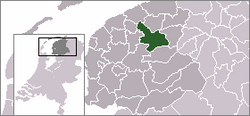
Romanesque architecture is an architectural style of medieval Europe characterized by semi-circular arches. There is no consensus for the beginning date of the Romanesque style, with proposals ranging from the 6th to the 11th century, this later date being the most commonly held. In the 12th century it developed into the Gothic style, marked by pointed arches. Examples of Romanesque architecture can be found across the continent, making it the first pan-European architectural style since Imperial Roman architecture. The Romanesque style in England is traditionally referred to as Norman architecture.

A rib vault or ribbed vault is an architectural feature for covering a wide space, such as a church nave, composed of a framework of crossed or diagonal arched ribs. Variations were used in Roman architecture, Byzantine architecture, Islamic architecture, Romanesque architecture, and especially Gothic architecture. Thin stone panels fill the space between the ribs. This greatly reduced the weight and thus the outward thrust of the vault. The ribs transmit the load downward and outward to specific points, usually rows of columns or piers. This feature allowed architects of Gothic cathedrals to make higher and thinner walls and much larger windows.

Bourges Cathedral is a Roman Catholic church located in Bourges, France. The cathedral is dedicated to Saint Stephen and is the seat of the Archbishop of Bourges. Built atop an earlier Romanesque church from 1195 until 1230, it is largely in the High Gothic architectural style and was constructed at about the same time as Chartres Cathedral. The cathedral is particularly known for the great size and unity of its interior, the sculptural decoration of its portals, and the large collection of 13th century stained glass windows. It was declared a UNESCO World Heritage Site in 1992.
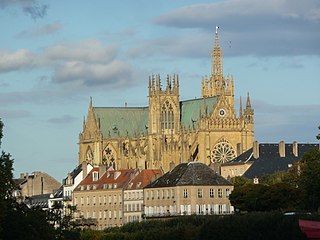
Metz Cathedral, otherwise the Cathedral of Saint Stephen, Metz, is a Roman Catholic cathedral in Metz, capital of Lorraine, France. It is dedicated to Saint Stephen. First begun in the early 14th century, it was joined together with the Collegiale of Notre Dame beginning in the md-14th century, and given a new transept and late Gothic chevet, finished between 1486 and 1520. It is the cathedral of the Roman Catholic Diocese of Metz as the seat of the bishops of Metz. The cathedral treasury displays the collection, assembled over 1,000 years, of the bishopric of Metz, including paraments and items used for the Eucharist.

Bremen Cathedral, dedicated to St. Peter, is a church situated in the market square in the center of Bremen, in northern Germany. The cathedral belongs to the Bremian Evangelical Church, a member of the Protestant umbrella organization named Evangelical Church in Germany. It is the previous cathedral of the former Prince-Archbishopric of Bremen. Since 1973, it is protected by the monument protection act.

Bordeaux Cathedral, officially known as the Primatial Cathedral of St Andrew of Bordeaux, is a Roman Catholic church dedicated to Saint Andrew and located in Bordeaux, France. It is the seat of the Archbishop of Bordeaux.

Troyes Cathedral is a Roman Catholic church, dedicated to Saint Peter and Saint Paul, located in the town of Troyes in Champagne, France. It is the episcopal seat of the Bishop of Troyes. The cathedral, in the Gothic architectural style, has been a listed monument historique since 1862.

French Gothic architecture is an architectural style which emerged in France in 1140, and was dominant until the mid-16th century. The most notable examples are the great Gothic cathedrals of France, including Notre-Dame Cathedral, Reims Cathedral, Chartres Cathedral, and Amiens Cathedral. Its main characteristics were the search for verticality, or height, and the innovative use of the rib vault and flying buttresses and other architectural innovations to distribute the weight of the stone structures to supports on the outside, allowing unprecedented height and volume, The new techniques also permitted the addition of larger windows, including enormous stained glass windows, which filled the cathedrals with light. The French style was widely copied in other parts of northern Europe, particularly Germany and England. It was gradually supplanted as the dominant French style in the mid-16th century by French Renaissance architecture.
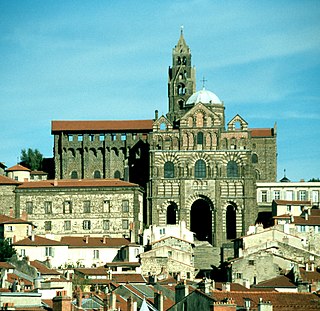
Le Puy Cathedral, sometimes referred to as the Cathedral of Our Lady of the Annunciation, is a Roman Catholic church located in Le Puy-en-Velay, Auvergne, France. The cathedral is a national monument. It has been a centre of pilgrimage in its own right since before the time of Charlemagne, as well as forming part of the pilgrimage route to Santiago de Compostela. Since 1998 it has been part of a multi-location UNESCO World Heritage Site along France's Santiago pilgrimage routes. It is the seat of the Bishop of Le Puy.

Jistrum is a village in Tytsjerksteradiel municipality in the province of Friesland of the Netherlands. It lies northeast of the Burgumer Mar and had a population of around 921 in January 2017.
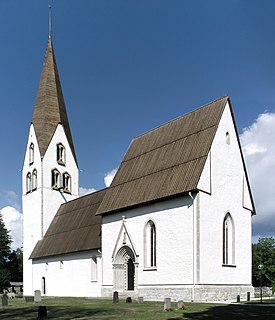
Garde Church is a medieval church in Garde on the Swedish island of Gotland. It was built in stages during the Middle Ages. The oldest part is the nave and the base of the tower, while the most recently constructed part is the large chancel. A large renovation was carried out in the 1960s. Garde Church together with its cemetery and its four lychgates constitute one of the most well-preserved medieval church ensembles in Sweden.

Hejde Church is a medieval Lutheran church in Hejde on the island of Gotland It lies the Diocese of Visby.

Hejnum Church is a medieval Lutheran church in Hejnum on the island of Gotland, Sweden. The church lies in the Diocese of Visby of the Church of Sweden.
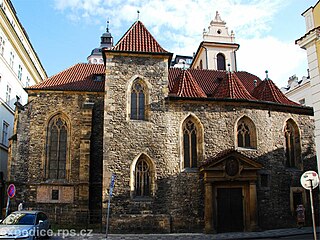
The Church of St. Martin in the Wall is a Gothic church with Romanesque grounds, situated in the Old Town of Prague, Czech Republic. It was built between 1178-1187 in the village of Újezd, thereafter known as Újezd u svatého Martina. The south wall of the church was built adjacent to the walls of the Old Town, hence the full name of the church "in the wall". The church belongs to the Evangelical Church of Czech Brethren.

St. Michael's Church in Jircháře, Prague - New Town near the National Theatre, specifically the New Town street, which is called v Jirchářích. It is the seat of Czech, Slovak and English congregation of the Evangelical Church of the Augsburg Confession in the Czech Republic. Its architectural style is not uniform due to alterations in different periods and styles. It is protected as a cultural monument of the Czech Republic.
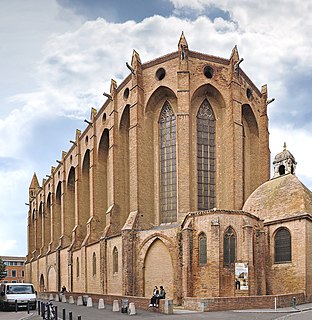
The Church of the Jacobins is a deconsecrated Roman Catholic church located in Toulouse, France. It is a large brick building whose construction started in 1230, and whose architecture influenced the development of the Gothique méridional style. The relics of Thomas Aquinas are housed there. In the two centuries following the dissolution of the Dominican Order at the time of the French Revolution, it served various different purposes before undergoing major restoration in the 20th century. In the early 21st century, it was partially converted into a museum.

St. Castulus church is a Gothic church with Romanesque and Baroque elements. It is located on the Castulus square, in Old town near Convent of Saint Agnes. It is the only church in the Czech Republic consecrated to Saint Castulus.

Romanesque architecture appeared in France at the end of the 10th century, with the development of feudal society and the rise and spread of monastic orders, particularly the Benedictines, which built many important abbeys and monasteries in the style. It continued to dominate religious architecture until the appearance of French Gothic architecture in the Ile-de-France between about 1140-1150.

Hjärsås Church is a medieval church in Hjärsås, Östra Göinge Municipality, Skåne, Sweden. It was built in the 1230s in a Romanesque style. Unusually, the church exterior is decorated with paintings possibly from the 16th century. The interior contains 16th-century murals of a style not found elsewhere in Skåne. The church lies in the Diocese of Lund.

Gothic cathedrals and churches are religious buildings created in Europe between the mid-12th century and the beginning of the 16th century. The cathedrals are notable particularly for their great height and their extensive use of stained glass to fill the interiors with light. They were the tallest and largest buildings of their time and the most prominent examples of Gothic architecture. The appearance of the Gothic cathedral was not only a revolution in architecture; it also introduced new forms in decoration, sculpture, and art.
























